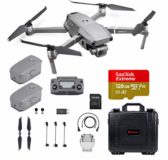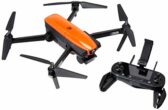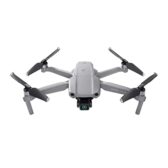The Best Photography Drones in 2021
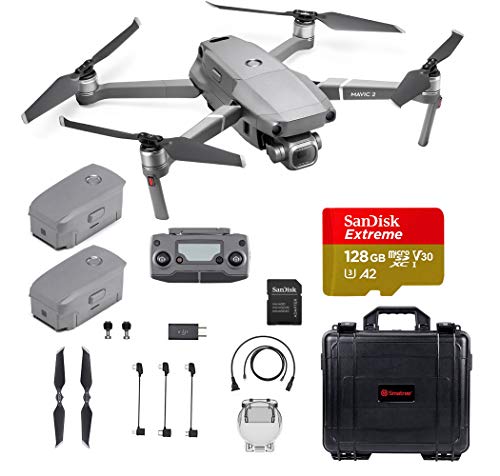
DJI Mavic 2 Pro
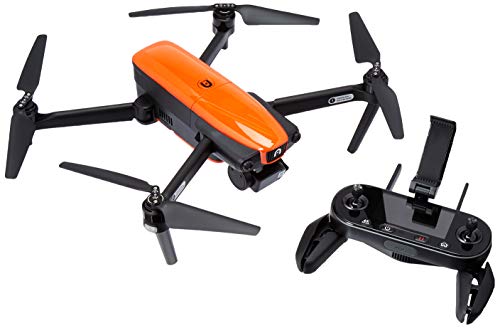
Autel Robotics EVO
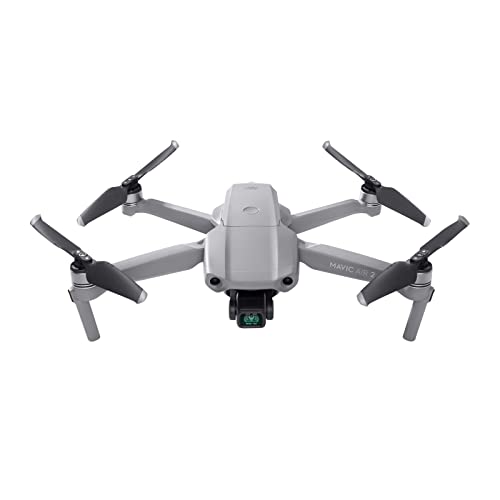
DJI Mavic Air 2
Ask most people why they want to buy a drone and you’ll get a lot of “because I want to take cool-looking aerial photos!” type answers.
Part of why drones exploded into the consumer market is because, due to social media, everyone wanted to become an amateur photographer. And the truth is that drones give you a lot of excellent new ways to take images, from a stunning landscape photo to something as simple as a selfie.
For the aspiring drone photographer, you’ve come to the right place. Today we’ve narrowed down the best models to get at varying budgets and skill levels.
So sit back and relax as we dive deep into the world of camera drones.
It’s worth noting that this post mainly focuses at those drones that will take the best quality photos. If you’re looking for a cheap drone with a camera then we have a separate roundup for them.
The Best Photography Drones of 2021
We may receive compensation on qualifying purchases via our links. This does not change how we review items. For more information, please read our affiliate disclosure.
This luxury drone is one of the best in the market and comes with a 4-figure price tag.

- Flight Time: 30 minutes
- Range: 7 kilometers
- Camera: 4K resolution at 30 fps; 20 MP stills
- Weight: 1.64 pounds
- Gimbal: 3 Axis
The best consumer photography drone, in our opinion, is the Mavic 2 Pro — with camera quality so good it could make your jaw drop. It’s one of the most incredible we’ve ever seen in a compact, foldable drone.
The Mavic 2 Pro is actually one half of the Mavic 2 family, the other being the Mavic 2 Zoom. Both are identical from features down to the frame, except for one crucial area: the camera.
The Zoom has a 1/2.3 inch CMOS sensor and a 24-88 mm optical lens. As the name suggests, it’s capable of up to a 2x zoom and is probably the sole reason you’d pick this one over the Pro (apart from price).
In terms of image quality, the Pro blows the Zoom right out of the water.
The Mavic 2 Pro has a Hasselblad L1D-20c camera with a 20 megapixel resolution. It has a 1” inch CMOS sensor, comparable to that of other high-end DJI drones like the Phantom 4 Pro.
This gives the Pro fantastic camera quality. The resolution is absolutely incredible, with a higher dynamic range and more excellent color definition. It’s actually comparable to shooting in RAW.
The amount of detail it captures in low light is quite commendable, with a maximum ISO of 12,800. For comparison’s sake, the previous Mavic Pro only had a 1/2.3 inch sensor and was capable of only a max ISO of 3,200. Pro also has a Hyperlight feature, which further enhances images shot in low light.
The Mavic 2 Pro also allows pro photographers to adjust the aperture from f/2.8 – f/1.1. This gives you even greater creative control over your shots.
Flight and camera stabilization is classic DJI, so expect it to excel in that regard. The 3-axis gimbal mount on the camera gives pretty smooth results, even during fast fly-bys. It also has other great additions like obstacle avoidance, autonomous flight, and 30+ minutes of flight time.
With incredible image quality and superb features, the Mavic 2 Pro is THE one to beat. It’s hard to believe this is a compact consumer drone. If you have the cash for this one, you won’t regret it.
+ Pros
A 4K drone with a 12MP camera that folds up for handy portability. It’s water-resistant, too!

- Flight Time: ~30 minutes
- Charge Time: ~210 minutes
- Range: 7050m / 4.4 miles
- Remote Controller: WiFi 2.4GHz (included in the set)
- Camera: 3-axis gimbal 4K 60fps camera with 12MP
- Live Video Transmission Range: 7000m / 4.3 miles
- Weight: 863g / 1.9lbs
- Carry Capacity: N/A
- Working Temperature: 0°C ~ 40°C
- Rated for outdoor use
The Autel EVO is one of the best photography, videography and Follow Me drones that you can buy. To this end, it features advanced autonomous flight modes, so you can focus on taking great-looking aerial shots.
The Follow Me Mode of the EVO is one particular feature. This is powered by Autel’s proprietary Dynamic Track technology, which uses a combination of camera data and sensors.
Dynamic Track allows the EVO to automatically track persons, vehicles, and other moving objects at speeds of up to 21 mph. It will then move and rotate the camera to keep up with the target, according to one of the three tracking modes you choose.
The first, Follow Mode, will let EVO track and follow the target from a fixed distance. If the subject moves forward or backward, the drone will fly back and forwards as well.
If you select Tripod Mode, EVO will not follow the target. Instead, it will just rotate the camera to keep the target locked in the center of the frame. Parallel Mode is similar to Follow Mode, but EVO will fly and track the object sideways instead.
Dynamic Track also features optional obstacle avoidance. When turned on, EVO will continually check for obstacles in its flight path. When it encounters one, it will automatically fly left or right to avoid it. You can also manually control the drone at any time during Dynamic Track.
The EVO’s Dynamic Track technology alone is worth getting this drone. The powerful 4K camera, easy to use remote controller, and safety features are all just icing on the cake.
Not just focusing on extravagant features, the EVO is also water-resistant and splash-proof.
For the serious photographer or cinematographer, we can’t recommend the Autel EVO enough.
+ Pros
- Cons
The Mavic Air 2 is a groundbreaking development in the mid-budget range. Almost no other drone compares for the price.

- Flight Time: 34 minutes
- Weight: 1.3lbs / 0.59kg
- Camera: 48MP with 4K/60FPS video
- Range: 10km / 6.2 miles
The DJI Mavic Air 2‘s quality isn’t much of a surprise to anyone that knows the drone space — we’ve been blown away with what this machine is capable of considering it falls way below the $1,000 price tag that is usually required for such a premium product.
Its 34 minutes of flight time is staggering given its size and price, making it one of the biggest battery life drones you’ll find.
The Mavic Air 2 has obstacle detection in three different directions and intelligent tracking, along with DJI’s ActiveTrack technology, to also make this one of the best bang-for-the-buck follow me drones that there are.
With a 48MP 1/2-inch CMOS sensor camera and 4K video supported by a 3-axis gimbal, this is a brilliant option for anyone looking to take premium quality photos and videos without having to spend an arm and a leg.
+ Pros
- Cons
Our top rated mini drone with huge performance in a tiny body. Perfect for…everyone!
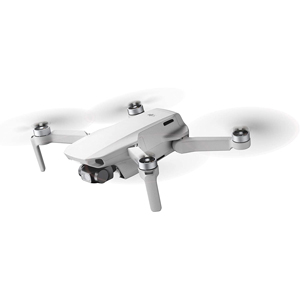
- This drone weighs less than 250g
- 12MP camera / 4K video, 4x digital zoom
- 3-axis motorized gimbal for image stability
- 10km range, max altitude of 4km
- Battery life: 31 minutes
DJI just can’t seem to stop releasing incredible drones.
The original Mavic Mini was our best ever value-for-money pick and now DJI have outdone themselves with the Mini 2.
We are blown away with the quality, performance and battery life that you can get with the DJI Mini 2 for a fairly affordable price. No, it’s not cheap, but its price falls far below most top products from competitors.
We’d say it’s now our favorite value-for-money pick by a long way, and it’s perfect for photography, videography, traveling, hobbyists and, well, everyone else too!
Better still, with its weight under 249g, it doesn’t even need to be registered with the FAA or CAA. That means you don’t need to be a registered drone pilot to fly this beauty.
+ Pros
- Cons
26 minutes of battery life and brushless motors give this foldable drone reliable, long-lasting performance.
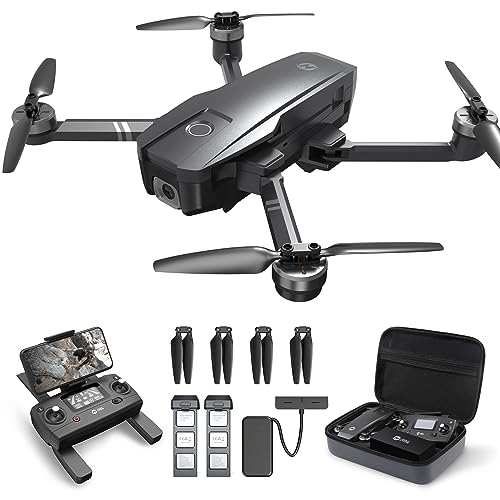
- Flight Time: ~26 minutes
- Charge Time: 5-7 hours
- Range: 800-1000m / 2624-3277ft
- Remote Controller: 2.4GHz transmitter included
- Camera: 2K HD (2048 x 1152) with shock absorption
- Weight: 459g / 1.01lbs
- Rated for outdoor use
Holy Stone is known for releasing drones with great specs at affordable prices. With the HS720, they are applying that tactic in a high end drone.
The HS720 is equipped with 2K resolution and a 1/3 CMOS sensor, both working in tandem to produce surprisingly stunning photos. We say stunning because the price range of the HS720 is definitely way below that of comparable models from DJI or Yuneec.
It also doesn’t have a gimbal equipped; instead, it uses a proprietary shock absorption technology to reduce camera vibrations from drone movements. However, it does allow remote tilting of the camera by up to 90 degrees vertically.
So how does this all translate to image quality? For the price, it’s impressive. Reasonably crisp with a good definition. Of course, it won’t beat DJI quality when compared side by side, but honestly, you won’t notice it on its own.
In terms of flight modes and capabilities, the Holy Stone is actually above average compared to others in its price tier. In fact, it might even be slightly better than the Parrot Anafi at half the price.
The HS720 flies great, and it can maintain its altitude pretty well thanks to a combination of sensors and GPS. You have the usual beginner flight modes like Headless Mode, making it easier for newbies to control.
Then there are the usual autonomous flight modes like Follow Me, Orbit, and Custom Flight Path. They do a fantastic job at creating some cool looking shot perspectives; plus, they work as advertised when we tried them out.
So if you’re on the market for a casual photography drone on a mid-range budget, we would highly recommend the HS720.
+ Pros
- Cons
The Tello Quadcopter is a great value option for those looking for a more budget-friendly way into the drone space.
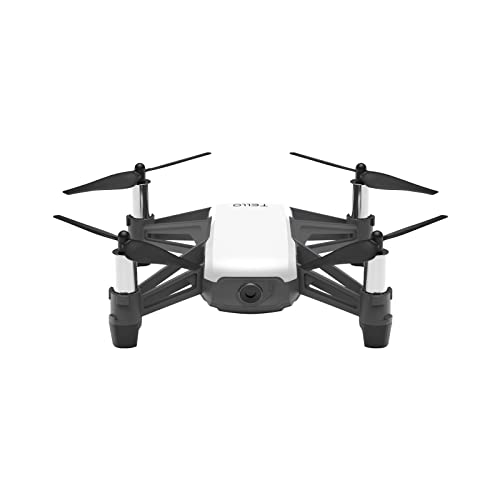
- Flight Time: 10-15 minutes
- Charge Time: 75 minutes
- Range: 100 meters
- Remote Controller: none included; uses a smartphone app for control
- Camera: 5 megapixels at 720p HD resolution
- Weight: 82g
- Rated for indoor and outdoor use
For the absolute best photography drone at a budget, nothing beats the Tello Quadcopter. Made with DJI components, this compact drone packs a lot of photography punch for such a small frame.
In a way, the Tello is as close as you can get to a DJI drone near the $100 price range.
The remarkable thing about this drone is that it has a relatively robust camera system. It’s equipped with a 5 megapixel camera with an 82-degree FOV. Not only that, but it has image stabilization built-in.
The result is great-looking photos with noticeably reduced blurring. The image definition is comparatively way better than other drones in its class.
And don’t forget, we’re talking about a budget drone here!
Thanks to DJI flight tech, the Tello is also a beast in the air. It’s easy to fly and highly maneuverable, whilst also being able to withstand gusts of wind. With its equipped vision sensors, it can also maintain a stable position while hovering in place.
The Tello has modes that are great for beginners, like one-button takeoff and landing, and auto-landing when it detects a critically low battery level. You can also choose between different speed levels, so you can practice at slower speeds.
Overall, if you’re looking to buy a budget drone to hone your photography skills, the Tello is a solid choice. It’s one of the better low-priced camera drones thanks to its 5 MP camera.
This is also a good drone to practice with if you don’t want to commit to a more expensive model just yet.
+ Pros
- Cons
No products found.
4K video, 12MP photos and 25-minute battery life for stunning aerial shots.
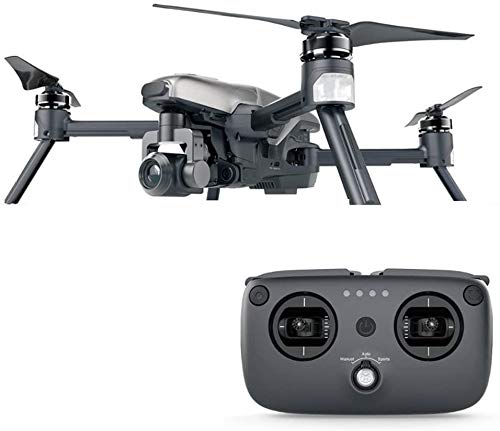
- Flight Time: 28 minutes
- Camera Resolution: 4K UHD
- Sensor Size: 1/2.3 inch CMOS
- Frame Rate: 30 fps and 60 fps
- Gimbal: 3-axis with 90-degree adjustable angle
- Weight: 890g
The Walkera Vitus 320 is a foldable and powerful photography drone from a manufacturer that’s primarily known for making excellent racers. That tradition is carried on to the Vitus 320, but instead of speed, you get an excellent photo drone.
The Vitus 320 sports a 12 megapixel camera, paired with a 1/2.3 inch CMOS sensor. This gives it plenty of photographic power capable of producing pretty stunning images. The color range and definition is fantastic as well, producing crisp and clear photos. Quality wise, you’d say it was at par with the Mavic Air or Pro.
The ISO range on the Vitus 320 has also been upped to 12,800, giving it cleaner images at low light. Sadly, the Vitus 320 doesn’t support saving using the RAW file format, limiting its editing capabilities somewhat.
The Walkera Vitus 320 has plenty of flight features that make it a great drone, performance wise. Of course, that is to be expected with a manufacturer of racing drones!
It’s equipped with a GPS/GLONASS system to make positioning that much more accurate. Combined with the onboard infrared sensors and optical flow camera, the Vitus 320 is much more aware of its environment.
This makes features like GPS Return and 3-way Obstacle Avoidance work exceptionally well. It can also hover itself in a stable, rock steady position. All in all, it makes for more effortless piloting.
The Vitus 320 comes with a bigger battery pack compared to the Mavic Pro, and you’d think it is a good thing. But the irony is that it results in overall lower battery capacity of 25 minutes on average. While impressive on its own, it doesn’t compare to the 30 minutes of a Mavic Pro.
But overall, the Walkera Vitus 320 is an excellent photography drone. Its compactness and foldable nature do not diminish its power in any way, making it a serious alternative to the DJI Mavic.
+ Pros
- Cons
No products found.
No products found.
The UPair 2 is one of the best value drones in the photography space, for both recreational and commercial use.
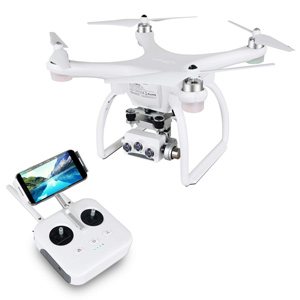
- Flight Time: 24 minutes
- Camera: 3-eye camera system at 16 megapixels
- Sensor Size: 1/2.3 inch CMOS
- Gimbal: 3-axis with adjustable pitch angle from -90 to 10 degrees
- Weight: 1.5 kg
The UPair Two might look like a DJI Phantom drone, but it has several features that make it pretty unique.
Chief among them is the 3-lens camera system, which is definitely a first for a drone. It has a primary camera with 16 megapixels of resolution and 4K UHD, while the other two lenses each sport 2K of resolution. Everything is backed up by a 1/2.3 inch CMOS sensor.
The image quality of the UPair Two is superb, to say the least. The 3-camera system is used for taking 3D photos, or at least gives you plenty of flexibility.
Surprisingly for the price, it also has a 3-axis gimbal that creates pretty stable shots. You can also use it to tilt the camera by up to 90 degrees in flight, which makes positioning shots more effortless than ever.
The flight capabilities of the UPair 2 are what you’d expect in your typical drone. For beginners, you have Headless Mode that makes controlling it that much easier. The GPS Return feature is particularly robust and offers you up to three modes on how and when your drone will return to its origin point.
Intelligent flight paths include Follow Me and Flight Path Planning, allowing you to plot a course using the smartphone app.
Overall, the UPair Two drone is a wonderful aerial photography platform at a fairly accessible price. You get a powerful 3-lens camera system combined with robust flight performance.
+ Pros
- Cons
No products found.
GPS, 4K video and a staggering 21 MP camera allows for some of the most beautiful drone shots imaginable.
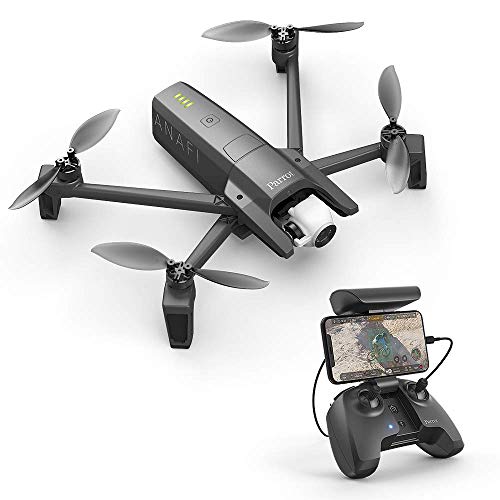
- Flight Time: ~25 minutes
- Charge Time: ~240 minutes
- Range: 4000m / 2.5mi
- Remote Controller: WiFi 5.4GHz & 2.4Ghz (included in the set)
- Camera: 180° adjustable f/2.4 ASPH lens 4K Camera with 21MP
- Live Video Transmission Range: 4000m / 2.5mi
- Weight: 320g / 11.28oz
- Working Temperature: -10°C to 40°C
- Rated for indoor and outdoor use
The Parrot Anafi is a compact and foldable drone that’s meant as a first time drone for beginners. Despite this, it’s a small and powerful drone, with excellent photo capabilities.
The Anafi is equipped with 21 megapixel camera, paired with a 1 / 2.4 inch CMOS sensor, comparable to the first generation Mavic. This allows you to shoot really high definition photos with rich detail and dynamic range. It’s a killer combo at that price, that’s for sure.
It has decent low light performance capable of a maximum ISO of 3200, although it doesn’t have much in the way of low light shooting modes.
Supporting the camera is a 180-tilt gimbal, which allows vertical rotation of the camera. It certainly is convenient for making some fine-tune adjustments to get that framing just right. The f/2.4 23mm lens is great for taking wide-angle shots, perfect for sweeping landscapes.
The Anafi also has plenty of flight features to help out with landing that perfect shot. The overall performance of this drone is excellent, it has a quiet operation and responsive control, thanks to the ergonomic Skycontroller 3 remote controller.
It has smart flight modes like Return to Home to make it go back to its point of origin automatically. Follow Me and Cameraman are great autonomous features for taking selfies and incredible shots unassisted.
With a compact frame, exceptional camera, and flight features, the Parrot Anafi is a phenomenal photography drone.
+ Pros
- Cons
No products found.
Hold on, a drone with a 4K resolution camera for less than $200? Yep.
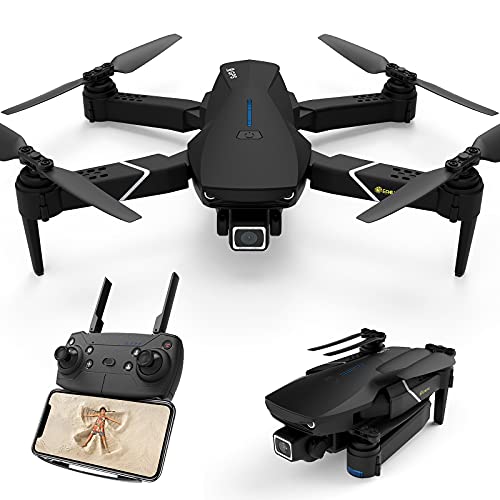
- Flight Time: 14 – 16 minutes
- Range: 250 meters
- GPS Equipped: Yes
- Flight Modes: GPS One Key Return, Follow Me, Altitude Hold, GPS Position, Waypoint, Orbit
- Camera: 5G WiFi 4K resolution with 120-degree wide-angle FOV
- Weight: 280g
At first glance, you’d think the Eachine E520S is a DJI drone. From the looks of it, it was clearly inspired by the Mavic series, with the iconic frame and even down to how its folded
Indeed, this drone mirrors the specs of the DJI version, but at a significantly lower price. But how does it hold up?
First, let’s take a look at the camera. The E520S also features a 4K resolution camera as the Mavic – which is pretty surprising given the price range. It has a 120-degree FOV and a 5G WiFi connection for transmitting real-time video.
However, when compared to the original, it falls a bit short. For one, it doesn’t have a gimbal installed. This means the camera is not stabilized, and is highly prone to jittery movement, resulting in more blurry images.
The image quality also doesn’t hold up when compared side by side. It just doesn’t have the large 1″ CMOS sensor as the DJI, which gives the original an edge over photo quality.
But that doesn’t mean the E520S’s photos suck – they’re actually exceptional and definitely way better than other comparable models in its price range. Judged on its own, I’d say this drone delivers.
Flight performance-wise, The E520S is exceptional. The drone is easy to fly thanks to its friendly features like Altitude Hold, which does an excellent job of stabilizing it while on the air. You also have access to a suite of intelligent flight modes like Waypoint, Orbit, and the ever-popular Follow Me.
Safety features like GPS Return make it safe to use outdoors, and you don’t need to be as cautious with it. This allows you to focus more on taking great photos. Flight time is also above average, at 16 minutes.
On its own, the Eachine E520S is a good photography drone at a slightly budget price. It offers commendable flight performance, a high resolution camera, and intelligent features.
+ Pros
- Cons
No products found.
A fast, affordable drone with decent battery life, capable of recording 2K video footage.
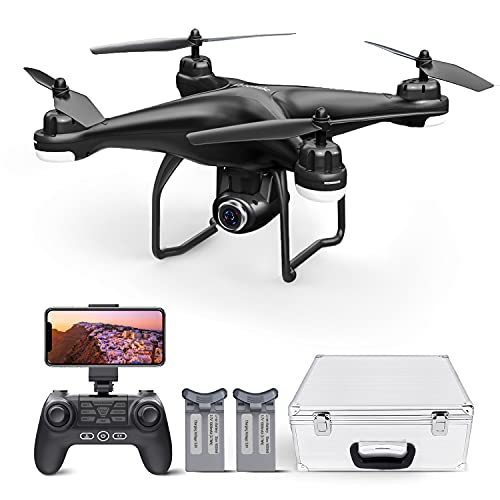
- Flight Time: 20 minutes
- Range: Up to 1500 metres
- Camera Resolution: 1080p HD
- Weight: 525g
The D85 is one of the best drones from Potensic, known for making quality models at an affordable price. It’s actually a multipurpose drone, capable of being a camera, recreational and even a racing drone.
The camera installed is a fixed 2K camera with a wide 130 degrees FOV. This makes it one of the wider angled camera drones in the market, which mostly tops at 120 FOV.
With it, sweeping landscape views are a breeze, which is an excellent subject to take pictures with the D85. The camera quality is pretty good, given the price.
Sadly, it doesn’t have a gimbal installed, so it would be prone to sudden jerky movement. You’d need to be extra careful while taking photos with the D85, which can detract a little bit from the fun of shooting.
Fortunately, it makes up for it with its other features.
It has an onboard GPS, which gives it access to a range of autonomous flight functions. Chief among them is Auto Return, which directs the drone to fly back to its takeoff point if it encounters a lost connection or critical battery level.
Then you have the choice of intelligent flight modes like Follow Me and Custom Flight Paths.
Flight performance is also where this drone shines. We mentioned that you can use the D85 as a racing drone, and that’s mostly because of its speed. It can top 50 km/h, which puts it at range with a lot of mid-level racing drones.
You can also utilize FPV mode, and since it has a wide 130-degree FOV, you get a much broader view. 5G WiFi connection also ensures lag-free, zero latency streaming.
Overall, the Potensic D85 is a flexible all-purpose drone that fortunately does a lot of things right, photography included.
+ Pros
- Cons
How To Choose A Photography Drone
Before you go about choosing a photography drone, you have to ask yourself why. Why do you want to get one?
OK, you might say, “Duh! It’s for taking photos!”
But wanting to buy a drone for photography is still a pretty broad reason.
You have to narrow it down. Would you be using your drone for taking photos during your vacation? Or are you a professional photographer who wants to make the highest quality images possible?
What is your purpose?
Knowing your true purpose will make it much easier to narrow down on the camera drone that you would get. Because in today’s market, there are tons of drone options out there, and it’s easy to get lost in all that noise if you have no idea what you want.
To borrow a photography term: you have to focus!
To help you out, here are a few ways you might need a photography drone. See if one or more resonates with you:
I’m a professional photographer wanting to get into drones
If you’re a professional photographer who wants to add drone shots to your arsenal of skills, then the best image quality is your number one priority. You’ll want the highest camera resolution and sensors, plus extended flight time and stability.
At the minimum, you’ll ideally be looking at a price range of $1,000. You could potentially get one in the $500-$800 range, but more can afford you cameras in the 20 megapixel or better range, with better stabilization features and manual control.
The good news is that some of the best photography drones can match the specs and quality of the top SLR cameras. They also use roughly the same conventions, so your experience in buying cameras would serve you well when shopping for drones.
I want a drone to take when I’m out on vacation
For the casual user who wants to take great-looking photos when on vacation, for example, the image quality will still be one of your considerations. But you don’t necessarily need to aim for the highest camera specs possible.
A decent mid-range camera drone will actually give you a crisp and stunning image that’s more than enough for posting to your social media or family album. Anything more than that (approaching pro level) will not be practical anymore for this purpose.
It would be better to look for other features like ease of flight and autonomous flight modes, especially if you travel alone. Longer battery life is useful as well, so you can continue shooting uninterrupted.
Lastly, you want your drone to be as portable as possible. You can either pick a compact one or opt for a foldable drone. The important thing is that you can easily pack/unpack and fly it with minimal setup.
I have no idea how to fly a drone yet
If you haven’t flown a drone before, you’ll want to choose a photography drone with beginner flight features. Some of these have the ability to do takeoff/landing with just one button, which is really convenient.
You’ll almost always need a GPS drone, so you can get access to features like Auto Return and Altitude Hold. Both are great “training wheels” to help you safely fly your drone as quickly as possible without prior experience.
Autonomous flight modes, like Follow Me and Waypoint, are also indispensable for newbie pilots.
But remember, these are just crutches. It can never replace actually flying the drone yourself. So, take the time to develop your drone piloting skills! If you need some starter drones to practice on, check out our article on the best beginner drones.
What to Look For In A Photography Drone
Today’s drones have cameras that are getting more and more sophisticated as the years go by. In fact, a lot would have the same capabilities as a top-notch SLR camera.
Unfortunately, unless you’re a pro photographer, you might have a hard time discerning between all the technical jargon. It can get overwhelming pretty quickly.
But it doesn’t have to be. The key is knowing what you want to achieve from the get-go and looking for specs that can deliver that.
In getting a photography drone, image quality is your primary goal. Thing is, how your images will turn out is a result of several different factors, all working together.
Let’s list a few here, so you know what to look for in a photography drone.
Camera Resolution
The drone camera’s resolution refers to how much detail it can capture. Better resolutions lead to crisper images, especially when you zoom it in or blow it up.
For still images, camera resolution is measured in megapixels. To understand this a bit more, let me explain first how your drone camera stores the photos you take.
Any digital photo is made up of tiny squares called pixels. Each pixel represents a single color, like pieces of a mosaic. Try zooming any picture on your computer enough, and you’ll see these tiny squares form the actual image.
The more pixels in an image, the more detail it has. You’ll also be able to enlarge it more without it becoming pixelated – jaggy and distorted.
A megapixel is equivalent to a million pixels. A 20 MP camera, then, is able to capture 20 million pixels worth of data. The higher the megapixels, the better the detail.
A lot of people will base their drone camera purchases solely on the megapixel count, thinking that higher MP = better image quality. But this isn’t necessarily true in most cases.
A camera’s megapixel is only one part of the equation of image quality. Yes, it tells you the amount of detail that the camera can capture. But it tells you nothing about how it captures it.
For instance, a high megapixel camera with a mediocre lens will produce a subpar image, no matter how much detail it can capture. So while megapixel is an important consideration, it’s not the only consideration. In fact, it’s not even that vital.
The truth is that megapixels offer diminishing returns. Past a certain point, higher megapixels will giver smaller and smaller improvements in image quality.
So, we recommend going for a decent MP (around 12-15 megapixel is adequate enough) and then looking at other specs to get better returns on image quality.
Camera Sensors
While a camera’s megapixel is essential, what truly gives fantastic image quality is the size of the camera’s sensors.
The camera’s sensors are what ultimately records the image you take with the camera. Lights that enter the lens get “imprinted” on the sensors, translating it into the final image we see.
Bigger sensors would be capable of capturing more light information, and therefore more definition. You would get images with better quality, less noise, and better photos during low light.
The majority of camera drones use the CMOS sensor and are sized anywhere from 1/3 inch all the way to 4/3 inch. For comparison’s sake, a typical smartphone camera would have a 1/3 inch sensor.
Professional drones, like the DJI Phantom, would have a 1-inch sensor. This is an excellent size to shoot for if you’re a pro photographer and want really high-quality photos.
For the typical amateur photographer, however, a smaller CMOS sensor would suffice. For non-professionals, a smaller sensor would matter only if you continuously shoot in low light conditions, as it would give you better image detail with less noise.
Field of View (FOV)
A camera’s field of view refers to how wide or narrow a camera can “see.” The FOV is dependent on two things – the drone camera’s sensor size and the focal length of the lens. Drone specs would specify this as a degree value, usually ranging from around 70 degrees to 130 degrees.
If your drone has a wide FOV, then things would appear zoomed out. This allows you to take a photo of a more prominent or far away subject, perfect for sweeping environments.
As the FOV gets wider and wider, it introduces a “fish-eye” effect. This is when the sides of the image get distorted, like seeing through the eyes of a fish. This is generally not desirable unless you deliberately want this effect in your photos.
Now, if you have a narrower FOV, the opposite happens. Everything is more up close, and there is minimal distortion in the image.
It’s important to know that there is no “good” or “bad” FOV; it’s mostly a matter of preference. If you like shooting a lot of landscape and nature shots, then a wider FOV might be useful. For selfies or more tighter camera work, stick with a lower FOV.
FOV also matters when you’re using your drone’s First Person View (FPV) mode, during racing, for example. Having a wider FOV will allow you to see more of your environment, and makes maneuvering easier.
Shooting Modes and Manual Control
All modern cameras will let you shoot in automatic mode, meaning you just point and shoot. The camera will make all the adjustments in the background to make sure you get a well-exposed photo.
While this is great, having the ability to manually adjust these settings yourself will give you far greater control over the quality of your image. This is actually what separates the pros from the amateurs.
High-end professional drone cameras will let you control one or all of three things: shutter speed, aperture, and ISO. These settings are the holy trinity of photography, the three “levers” you use to fine-tune your image.
If you’re aiming for a professional output, you’ll want a drone camera that lets you control these three things. It will afford you maximum flexibility to nail down those creative shots
For newbie photographers, however, having to adjust a lot of settings can be overwhelming, and even detrimental. Getting the settings wrong will lead to an over or under-exposed image. For casual users, manual control isn’t much of an issue.
Gimbal Stabilization
Ever tried to take photos from a moving car that suddenly stops? You’ll be hard-pressed to take crystal clear images.
Well, the same is true with drones. Any sudden, dramatic movement on the drone while you’re taking photos will make your images very blurry.
The solution is a device called a gimbal. It’s mounted on the camera and has the ability to rotate it independent of the drone. Whenever the gimbal encounters any dramatic movement from the drone, it will try to stabilize the camera to try and negate that movement.
The result is the camera remains steady, free to take blurry-free photos.
You should get a gimbal-equipped drone if you can, as it can have a significant impact on photo quality. This is especially true if you take a lot of action shots, or when you use autonomous modes like Follow Me a lot. Even if you take photos will the drone is stationary, it can still introduce micro-movements that will affect your photo.
Flight Stability
Of course, a gimbal can only do so much. If your drone can’t even hover properly in place, it will introduce a lot of blur in your images, regardless of how stabilized your camera is.
Your drone’s flight stability might not be directly related to your camera, but it has a significant impact on your photo quality than you might think. Try picking a drone that can stabilize itself while hovering in place, such as those with Altitude Hold mode.
On a minor note, you also want a drone that’s easy to fly. It makes it easier for you to position it to take great shots.
Support for RAW Format
Today’s higher-end camera drones will have support for RAW. This is a photography file format that stores all of the “raw” data from the camera’s sensor, unedited and uncompressed.
RAW format is vital for pros because it gives them plenty of detail to work with in the editing stage. It’s possible to pull in more detail from shadows or blown-out highlights because the data wasn’t really removed there, unlike in other formats like JPG.
With the RAW format, you can take a good photo and make it really exceptional.
Of course, this more or less only applies to professional photographers, or if you plan to edit your photos heavily. If you aim just to shoot and post it straight to Instagram, then it might not matter.
Aerial Drone Photography Tips
Drone photography has its own sets of challenges and limitations that set it apart from regular photography. To make the best images possible with your drone, here are some simple tips you can follow:
Use the Rule of Thirds
This is a rule of composition in photography that says the main subjects of a photo should fall just a little bit off-center. Why? Because it just looks better and more natural.
You can use a grid layout for this purpose, Drone remote controllers will usually have a grid overlay option that shows this on your screen display. Utilize it as a handy guide to quickly take well-composed shots
See things from a different perspective
You should always maximize the freedom drone photography gives you. Try to find a new perspective or angle from which to shoot your subject. Maybe try looking at it from overhead or from the side.
Chances are, such a view hasn’t been photographed before. And just like that, you have yourself a unique image. Don’t be afraid to experiment!
Brush up on your drone skills
While using a drone’s autonomous flight features can get you pretty pictures, there are still some complex angles or perspectives they might not be able to do. That’s why there’s no substitute for flying the drone yourself to achieve unique perspectives.
This, of course, entails you flying the drone yourself. So try to practice whenever you can to increase your confidence level on your flying skills.
Try to work at 100 ISO
While your camera drone is capable of ISOs way into the 1,000s, it doesn’t mean it’s a good idea to do so. Drone cameras, just like their SLR counterparts, perform poorly at higher ISO levels. It introduces way too much noise that makes the photo look grainy.
If you’re trying to compensate for low light conditions, adjust other things like shutter speed or aperture instead. Only tweak the ISO setting as a last resort.
Make the most of your drone’s flight time
If your drone has an unusually short flight time, then you need to maximize that. One way to achieve this is by planning ahead. This avoids wasting your precious flight time thinking about the next thing to shoot.
Before taking off, visualize clearly the shots that you want to achieve. Plan the route that your drone is supposed to take (or set it as waypoints if your drone supports that feature), then stick with it.
Check the forecast
We know how exciting drone photography is. But before you go out on a session, it pays to know the weather forecast first! Particularly nasty weather is more than enough to ruin your day and possibly your drone!
You can use a website like UAV Forecast to help you plan ahead. This gives you critical information on a given area to see if it’s safe to fly a drone or not. It can also tell you the availability of GPS satellites in the area, to see if you can use your drone’s GPS features accurately.

